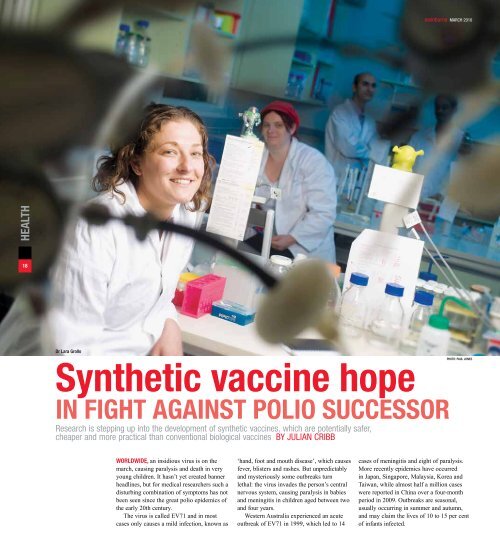March 2010 - Swinburne University of Technology
March 2010 - Swinburne University of Technology
March 2010 - Swinburne University of Technology
You also want an ePaper? Increase the reach of your titles
YUMPU automatically turns print PDFs into web optimized ePapers that Google loves.
swinburne <strong>March</strong> <strong>2010</strong><br />
health<br />
18<br />
Dr Lara Grollo<br />
Synthetic vaccine hope<br />
Photo: Paul Jones<br />
in fight against polio successor<br />
Research is stepping up into the development <strong>of</strong> synthetic vaccines, which are potentially safer,<br />
cheaper and more practical than conventional biological vaccines By Julian Cribb<br />
Worldwide, an insidious virus is on the<br />
march, causing paralysis and death in very<br />
young children. It hasn’t yet created banner<br />
headlines, but for medical researchers such a<br />
disturbing combination <strong>of</strong> symptoms has not<br />
been seen since the great polio epidemics <strong>of</strong><br />
the early 20th century.<br />
The virus is called EV71 and in most<br />
cases only causes a mild infection, known as<br />
‘hand, foot and mouth disease’, which causes<br />
fever, blisters and rashes. But unpredictably<br />
and mysteriously some outbreaks turn<br />
lethal: the virus invades the person’s central<br />
nervous system, causing paralysis in babies<br />
and meningitis in children aged between two<br />
and four years.<br />
Western Australia experienced an acute<br />
outbreak <strong>of</strong> EV71 in 1999, which led to 14<br />
cases <strong>of</strong> meningitis and eight <strong>of</strong> paralysis.<br />
More recently epidemics have occurred<br />
in Japan, Singapore, Malaysia, Korea and<br />
Taiwan, while almost half a million cases<br />
were reported in China over a four-month<br />
period in 2009. Outbreaks are seasonal,<br />
usually occurring in summer and autumn,<br />
and may claim the lives <strong>of</strong> 10 to 15 per cent<br />
<strong>of</strong> infants infected.
















